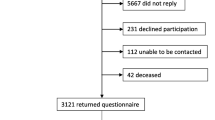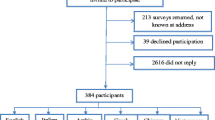Abstract
Objectives
This paper compares estimates of poor health literacy using two widely used assessment tools and assesses the effect of non-response on these estimates.
Study Design and Setting
A total of 4,868 veterans receiving care at four VA medical facilities between 2004 and 2005 were stratified by age and facility and randomly selected for recruitment. Interviewers collected demographic information and conducted assessments of health literacy (both REALM and S-TOFHLA) from 1,796 participants. Prevalence estimates for each assessment were computed. Non-respondents received a brief proxy questionnaire with demographic and self-report literacy questions to assess non-response bias. Available administrative data for non-participants were also used to assess non-response bias.
Results
Among the 1,796 patients assessed using the S-TOFHLA, 8% had inadequate and 7% had marginal skills. For the REALM, 4% were categorized with 6th grade skills and 17% with 7–8th grade skills. Adjusting for non-response bias increased the S-TOFHLA prevalence estimates for inadequate and marginal skills to 9.3% and 11.8%, respectively, and the REALM estimates for ≤6th and 7–8th grade skills to 5.4% and 33.8%, respectively.
Conclusions
Estimates of poor health literacy varied by the assessment used, especially after adjusting for non-response bias. Researchers and clinicians should consider the possible limitations of each assessment when considering the most suitable tool for their purposes.

Similar content being viewed by others
References
Ratzan SC. Health literacy: Communication for the public good. Health promot Int. 2001;16:207–14.
Baker DW, Gazmararian JA, Williams MV, Scott T, Parker RM, Green D, et al. Functional health literacy and the risk of hospital admission among Medicare managed care enrollees. Am J Public Health. 2002;92:1278–83.
Baker DW, Parker RM, Williams MV, Clark WS, Nurss J. The relationship of patient reading ability to self-reported health and use of health services. A J Public Health. 1997;87:1027–30.
Baker DW, Wolf MS, Feinglass J, Thompson JA, Gazmararian JA, Huang J. Health literacy and mortality among elderly persons. Am J Public Health. 2007;167(14):1503–9.
Nielsen-Bohlman LT, Panzer AM, Kindig DA. Health Literacy: A prescription to end confusion. Washington, DC: Institute of Medicine of the National Academies, The National Acadamies Press; 2004.
DeWalt DA, Berkman ND, Sheridan S, Lohr KN, Pignone MP. Literacy and health outcomes: a systematic review of the literature. J Gen Intern Med. 2004;19:1228–39.
Parker RM, Baker DW, Williams MV, Nurss JR. The test of functional health literacy in adults: a new instrument for measuring patients’ literacy skills. J Gen Intern Med. 1995;10:537–41.
Baker DW, Williams MV, Parker RM, Gazmararian JA, Nurss JR. Development of a brief test to measure functional health literacy. Patient Educ Couns. 1999;38:33–42.
Davis TC, Crouch MA, Long SW, Jackson RH, Bates P, George RB, et al. Rapid assessment of literacy levels of adult primary care patients. Fam Med. 1991;23:433–35.
Bennett IM, Kripalani S, Weiss BD, Coyne CA. Combining cancer control information with adult literacy education: opportunities to reach adults with limited literacy skills. Cancer Control. 2003;10(5 Suppl):81–3.
Gazmararian JA, Baker DW, Williams MV, Parker RM, Scott TL, Green DC, et al. Health literacy among Medicare enrollees in a managed care organization. JAMA. 1999;281:545–51.
Paasche-Orlow M, Parker R, Gazmararian J, Nielsen-Bohlman L, Rudd R. The prevalence of limited health literacy. J Gen Intern Med. 2005;20:175–84.
Parikh NS, Parker RM, Nurss JR, Baker DW, Williams MV. Shame and health literacy: The unspoken connection. Patient Educ Couns. 1996;27:33–39.
Baker DW, Gazmararian JA, Sudano J, Patterson M. The association between age and health literacy among elderly persons. J Geront, Ser. B Psychol Sci Soc Sci. 2000;55:S368–74.
Borson S, Scanlan J, Brush M, Vitaliano P, Dokmak A. The Mini-Cog: A cognitive ‘vital signs’ measure for dementia screening in multi-lingual elderly. Int J Geriatr Psychiatry. 2000;15:1021–27.
Sheikh K, Mattingly S. Investigating non-response bias in mail surveys. J Epidemiol Community health. 1981;35(4):293–6.
Davis TC, Long SW, Jackson RH, Mayeaux EJ, George RB, Murphy PW, et al. Rapid estimate of adult literacy in medicine: a shortened screening instrument. Fam Med. 1993;25:391–95.
Davis TC, Michielutte R, Askov EN, Williams MV, Weiss BD. Practical assessment of adult literacy in health care. Health Educ Behav. 1998;25:613–24.
Nurss J, Parker R, Williams MV, Baker DW. TOFHLA-Test of Functional Health Literacy in Adults Manual. Camp, NC: Peppercorn Books and Press; 2001.
Chew LD, Bradley KA, Boyko EJ. Brief questions to identify patients with inadequate health literacy. Fam Med. 2004;36:588–94.
Chew LD, Griffin JM, Partin M, Noorbaloochi S, Grill J, Snyder A, et al. Validation of screening questions for limited health literacy in a large outpatient population. J Gen Intern Med. 2008;23:561–66.
Kutner M, Greenberg E, Jin Y, Paulsen C. The Health Literacy of America’s Adults: Results From the 2003 National Assessment of Adult Literacy (NCES 2006-483). Washington, DC: National Center for Education Statistics, US Department of Education; 2006.
Deyo R, Cherkin D, Ciol M. Adapting a clinical comorbidity index for use with ICD-9-CM administrative databases. J Clin Epidemiol. 1992;45:613–19.
Cochran W. Sampling Techniques. 3rd ed. New York: Wiley & Sons; 1977.
Allison PD. Missing Data. Thousand Oaks, CA: Sage Publications; 2001.
Rubin D. Multiple Imputation for Nonresponse in Surveys. New York, NY: John Wiley & Sons, Inc.; 1987.
US Department of Health and Human Services. Healthy People 2010. Understanding and Improving Health. 2nd ed. Washington, DC: US Government Printing Office; 2000.
Weiss BD, Mays MZ, Martz W, Castro KM, DeWalt DA, Pignone MP, et al. Quick assessment of literacy in primary care: the newest vital sign. Ann Fam Med. 2005;3(6):514–22.
Baker DW. The meaning and the measure of health literacy. J Gen Intern Med. 2006;21:878–83.
Sheikh K. Predicting risk among non-respondents in prospective studies. Eur J Epidemiol. 1986;2(1):39–43.
Cottler LB, Zipp JF, Robins LN, Spitznagel EL. Difficult-to-recruit respondents and their effect on prevalence estimates in an epidemiologic survey. A J Epidemiol. 1987;125(2):329–39.
McNutt LA, Lee R. Intimate partner violence prevalence estimation using telephone surveys: understanding the effect of nonresponse bias. A J Epidemiol. 2000;152(5):438–41.
Hardy RE, Ahmed NU, Hargreaves MK, Semenya KA, Wu L, Belay Y, et al. Difficulty in reaching low-income women for screening mammography. J Health Care Poor Underserved. 2000;11(1):45–57.
Kelly PA, Haidet P. Physician overestimation of patient literacy: A potential source of health care disparities. Patient Educ Couns. 2007;66:119–22.
Dolan NC, Ferreira MR, Davis TC, Fitzgibbon ML, Rademaker A, Liu D, et al. Colorectal cancer screening knowledge, attitudes, and beliefs among veterans: does literacy make a difference? J Clin Oncol. 2004;22:2617–22.
Eitelberg MJ, Laurence JH, Waters BK, Perelman LS. Screening for Service: Aptitude and Education Criteria for Military Entry. Office of the Naval Research. HumRRO FR-PRD-83-24. Alexandria, VA: Human Resources Research Organization; 1984.
Sticht, TG and Armstrong, WB.Adult Literacy in the United States. 1994. Retrieved February 8, 2010, from http://www.nald.ca/library/research/adlitUS/cover.htm.
Kirsch I, Jungeblut A, Jenkins L, Kolstad A. Adult literacy in America: A first look at the results of the National Adult Literacy Survey. Washington, DC: National Center for Education, US Department of Education; 1993.
Acknowledgements
This research was supported by the Department of Veterans Affairs, including a grant from VA Health Services Research and Development Service (CRI-03-151-1). Dr. Griffin also received support as a VA Merit Review Entry Program (MREP) awardee. Dr. Gralnek was supported by a VA HSR&D Advanced Research Career Development Award and IIS 01-191-1. The views expressed in this article are those of the author(s) and do not necessarily represent the views of the Department of Veterans Affairs or the United States Government. Part of this work was presented at the 24th Annual VA Health Services Research Meeting, Crystal City, VA, February 17, 2006. The authors wish to thank all the veteran participants for their time and the study interviewers for their commitment to this project.
Conflict of Interest
None disclosed.
Author information
Authors and Affiliations
Corresponding author
Rights and permissions
About this article
Cite this article
Griffin, J.M., Partin, M.R., Noorbaloochi, S. et al. Variation in Estimates of Limited Health Literacy by Assessment Instruments and Non-Response Bias. J GEN INTERN MED 25, 675–681 (2010). https://doi.org/10.1007/s11606-010-1304-2
Received:
Revised:
Accepted:
Published:
Issue Date:
DOI: https://doi.org/10.1007/s11606-010-1304-2




